June 2002
The Kaanapali Estate Coffee, Inc., Maui, Hawaii, USA is struggling to stay in existence. A lack of faith by the parent company AMFAC/JMB to further invest in their 14 year coffee project puts the unique beans and trees in jeopardy.
James 'Kimo' Falconer, vice-president of the Kaanapali company expressed frustration that he could get no money from the parent company to do much more than keep the trees alive by using the left over irrigation equipment from when it was a sugar plantation. Weeds currently overrun the entire 500 acres of Moka, Typica, Yellow Catuai, and Red Caturra trees, many as high as the trees themselves. As we gazed out his office window, he commented that the leaves on the trees were 'lightening up a bit from lack of nitrogen'. It seems fertilizer is also too much of an investment for AMFAC/JMB.
According to Falconer, a pending deal to save the trees and bring them back to their full production state is in the works with Kauai Coffee Company, and 'pretty much a done deal, except for the lawyers'. The 'deal' consists of Kauai leasing the property with the Red, Yellow and Typica trees, but there was no interest in the tiny 'Maui Moka' bean. Falconer said it was a problematic bean. When the experimental trees were planted in the early 90's, extensive research showed the Maui Moka varietal to be exceptionally adaptable to the Kaanapali location. It was derived from the Yemen Moka strain, and hopes for profitability in several years was expected. What they didn't expect was the unpredictability of the Moka harvests, and the exceptionally tiny beans that it produced. Falconer said it was so small it affected the overall weight of the harvest, and was not compatible with standard commercial roasting equipment, frequently causing problems by getting stuck in the roaster perforations or falling completely through. Harvests of many coffee trees show a predictable, repeating cycle of larger and smaller harvests, but the Moka seemed to be a 'wilder' tree than expected, and could not be depended on year after year.
In October 2001, Falconer said all the harvesting equipment was readied for harvest, workers were flown in and put up in local hotels, ready to begin the laborious machine harvest. On October 16, 2001 all were ready to pick, and a surprise directive from AMFAC/JMB instructed them not to begin the harvest. Falconer, clearly a businessman, said he was at a loss as to why they made that decision, but theorized that the unstable economy after the then-recent economic instability caused by the events of September 11 and the lack of expected profit from previous harvests was to blame.
He said his involvement has been directly 'hands-on' as the chief farmer on the plantation, and he's been on the project since it's inception. Although not directly spoken, his disappointment at the parent company pulling the plug was evident. There are no current plans to bulldoze the trees and turn it into condos or resorts as some have rumored, but there is no guarantee the acreage won't be converted to grow other agricultural products in the future if a solution cannot be found to make coffee profitable. Falconer said creative ideas have been tossed around to to find ways to make the plantation profitable, including the possibility of subdividing it into smaller (5 acres or so) plots and letting small coffee farmers buy into their own coffee plantation.
(Click the pictures to enlarge)
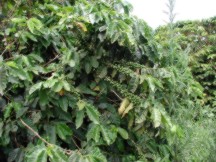
Trees heavy with green coffee cherries, but also weeds as tall as the trees.
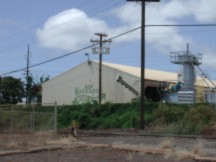
The Kaanapali processing plant is closed and partially dismantled, with only a skeleton of equipment left behind.
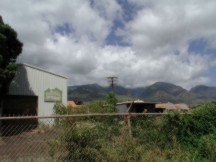
The run down processing plant is only a block from the beach, but is within view of the majestic cloud enshrouded mountains.
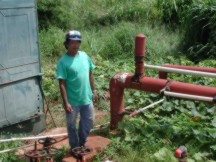
Domingo says he has been instructed to keep the trees watered. Irrigation equipment was left over from the old Pioneer Sugar Plantation.
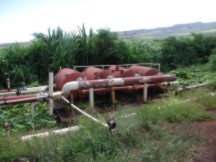
Trees can be watered, but not fertilized since no funds are allocated for fertilizer.
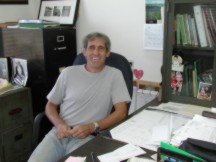
James 'Kimo' Falconer, in his office on the plantation directs the workers who tend the 500 acres of 'diversified agriculture', most of which is coffee. Pioneer, a subsidiary of AMFAC/JMB also hybridizes corn for shipment around the world at the Kaanapali site.
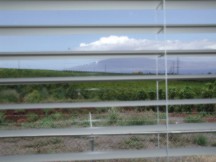
Falconer has a unique vantage point for contemplating business and farming decisions, looking out over lush coffee trees and the Pacific ocean.
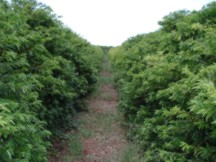
Trees are prolifically producing coffee cherry, but weeding and pruning money has not been allocated by AMFAC/JMB.
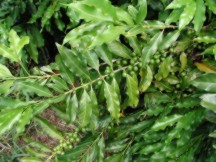
Harvest of ripe cherry in 2002 is pure speculation until someone invests in taking care of the trees and finding a way to harvest and process the ripe cherry.
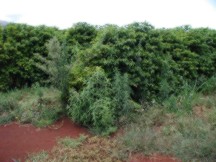
Pathways between trees and access roads are choked by weeds, but the trees are still producing plenty of cherry.
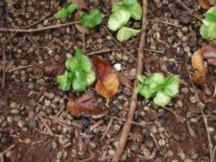
Coffee seedlings are sprouting from many of the beans on the ground that were not harvested in October 2001. I'm wondering how the nutrients from the fallen cherries affect this years crop???
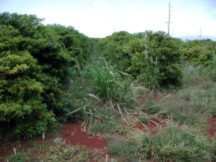
With all the weeds, they might qualify as 'shade grown'. The trees are in severe need of weeding, careful pruning and fertilizer before they can produce a quality bean typical of others in Hawaii such as the famous Kona.
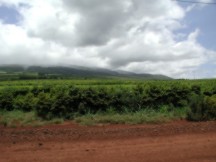
Most of the plantation is only a half mile or so from the beach, and probably only two or three hundred feet above sea level, but just below the majestic cloud enshrouded mountains. These are not 'high grown' coffee trees.
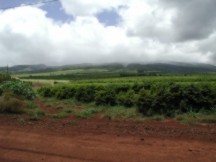
Coffee trees as far as the eye can see in some places. The misty clouds frequently dip down to enshroud the coffee trees.
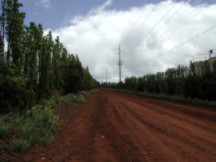
The trade winds and storms can be hard on coffee trees. Windbreaks like this are situated in strategic locations to protect the trees.
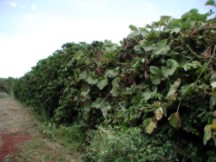
It was sad to see the neglect of these wonderful trees. Hopefully an investor will save the trees from their weed infested fate.
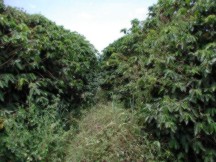
In many places, the rows are so overgrown by weeds and trees in need of pruning that they are impassable on foot.
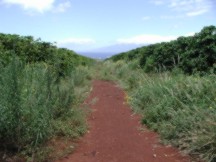
The Pacific Ocean is less than a mile from the plantation. The view looking down the access roads toward the ocean is breathtaking. Lanai Island is in the background.
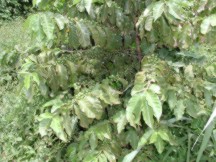
Many of the trees are producing thousands and thousands of cherries. I'm not sure if that is a good thing though if the tree and roots cannot fully nourish the beans.
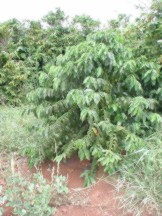
Pathways between trees and access roads are choked by weeds, but the trees are still producing plenty of cherry.
 TM
TM

 Back to the Main Menu
Back to the Main Menu
